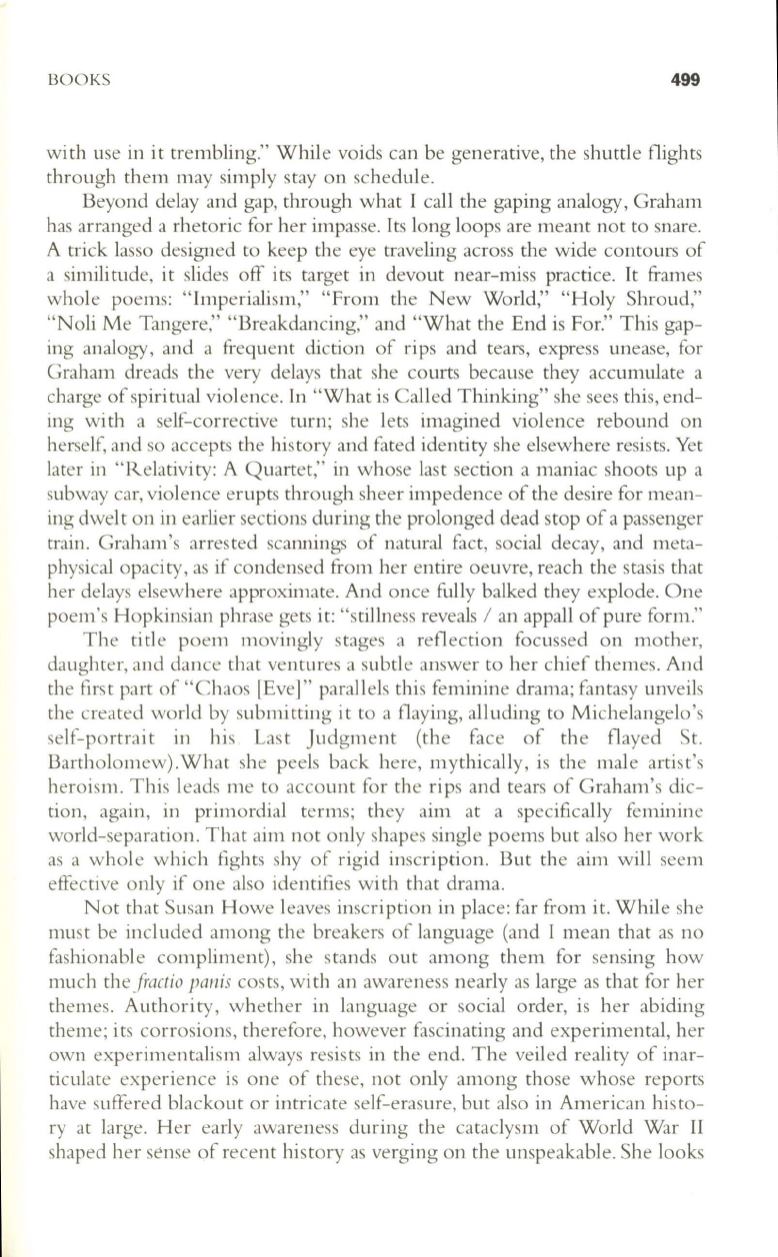
BOOKS
499
with use in it trembling." While voids can be generative, the shuttle flights
through them may simply stay on schedule.
Beyond delay and gap, through what I call the gaping analogy, Graham
has arranged a rhetoric for her impasse. Its long loops are meant not to snare.
A trick lasso designed to keep the eye traveling across the wide contours of
a simili tude, it slides off its target in devout near-miss practice. It frames
whole poems: "Imperialism," "From the New World," "Holy Shroud,"
"Noli Me Tangere," "Breakdancing," and "What the End is For." This gap–
ing analogy, and a frequent diction of ri ps and tears, express unease, for
Graham dreads the very delays that she courts because they accumulate a
charge of spiri tual violence. In "What is Called Thinking" she sees this, end–
ing with a self-corrective turn; she lets imagined violence rebound on
herself, and so accepts the history and fated identity she elsewhere resists. Yet
later in "Relativi ty: A Quartet," in whose last section a maniac shoots up a
subway car, violence erupts through sheer impedence of the desire for mean–
ing dwelt on in earlier sections during the prolonged dead stop of a passenger
train. Graham's arrested scannings of natural fact, social decay, and meta–
physical opacity, as if condensed from her entire oeuvre, reach the stasis that
her delays elsewhere approximate. And once fully balked they explode. One
poem's Hopkinsian phrase gets it: "stillness reveals / an appall of pure form."
The title poem movingly stages a reflection focussed on mother,
daughter, and dance that ventures a subtle answer to her chief themes. And
the first part of "Chaos [Eve]" parallels this feminine drama; fantasy unveils
the created world by submitting it to a flaying, alluding to Michelangelo's
self-portrai t in his Las t Judgment (the face of the flayed St.
Bartholomew).What she peels back here, mythically, is the male artist's
heroism. This leads me to account for the rips and tears of Graham's dic–
tion, again, in primordial terms; they aim at a specifically feminine
world-separation. That aim not only shapes single poems but also her work
as a whole which fights shy of rigid inscription. But the aim will seem
effective only if one also identifies with that drama.
Not that Susan Howe leaves inscription in place: far from it. While she
must be included among the breakers of language (and I mean that as no
fashionable cOl11.pliment), she stands out among them for sensing how
much the
fractio panis
costs, with an awareness nearly as large as that for her
themes. Authority, whether in language or social order, is her abiding
theme; its corrosions, therefore, however fascinating and experimental, her
own experimentalism always resists in the end. The veiled reali
ry
of inar–
ticulate experience is one of these, not only among those whose reports
have suffered blackout or intricate self-erasure, but also in American histo–
ry at large. Her early awareness during the cataclysm of World War II
shaped her sense of recent history as verging on the unspeakable. She looks


